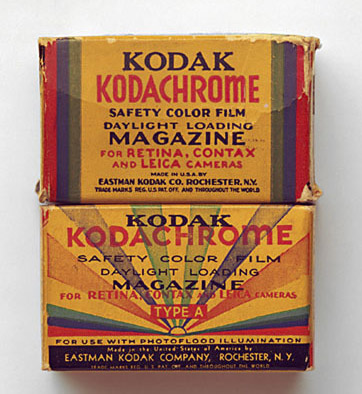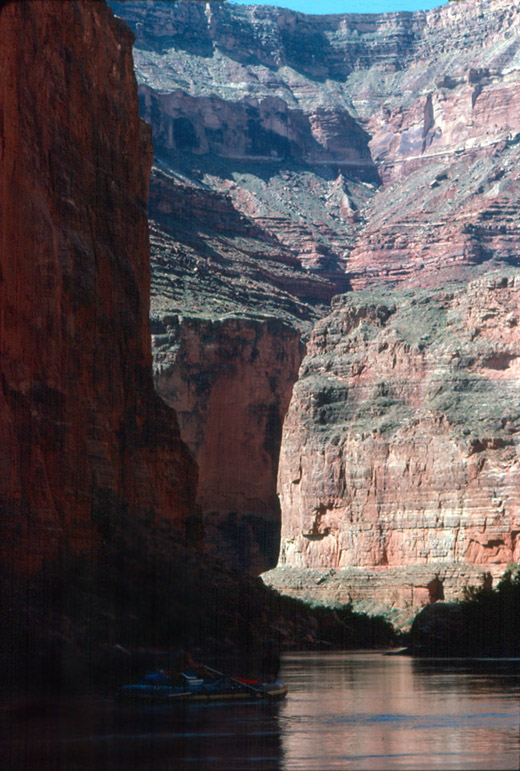Ode to Kodachrome
by Roger Kaza
Today, photographic memory. The University of Houston's Music School presents this program about the machines that make our civilization run, and the people whose ingenuity created them.
Old photos are often kind to us. They fade and soften along with our memories of the people in them. You feel the time gone by as much as you see it. But not all of our captured images are so considerate. A few weeks ago some of my family was in town, and we were watching a slide show of travels from 30 years ago. Just to clarify — and date myself — we're now talking about slides as in those little squares of cardboard with a piece of celluloid film sandwiched between them. The ones you watch on a movie screen, not your computer. As expected, some of my slides had faded badly. But not the ones shot in Kodachrome. Their light came flooding back in full force. They looked like they were taken yesterday.
Yet it's entirely possible that Kodachrome, renowned for its longevity, might not be around much longer. Now only one lab in the entire world attempts its finicky processing. And while the film can still be purchased for 35mm slides, many previous formats, such as those for 8 and 16mm movie cameras, have disappeared. So let's spend a minute celebrating a legendary film.

Rolls of Kodachrome have lined the camera bags of photographers for over 70 years. Yet, despite the name, Kodak really didn't invent it. It was the product of two over-talented teenage musicians, Leopold Godowsky II and Leopold Mannes. Both had famous musician parents and were pursuing music careers. But after seeing the 1918 film Our Navy, and lamenting its extremely primitive color quality, they went home and built their own movie camera, and projector. Then, while they were still in college, they patented a color film process using filters. But it was unwieldy and impractical. A few years later, though, on a music trip to Europe, Mannes chanced upon an investment banker who was intrigued with the boys' work. With his backing, Godowsky and Mannes continued to pursue their research. Finally, in 1930, Eastman Kodak recruited them to Rochester to create the film that would become Kodachrome.
Kodachrome is a remarkably fine-grained film, with exceptional color depth. For skin tones it is peerless — think of the famous National Geographic cover of the Afghan girl. But getting the correct exposure can be tricky. Kodachrome veterans often take three shots to guarantee that one will be good. You overexpose the first, underexpose the second, and let the camera's meter choose the third. The depth of resolution is staggering. One estimate suggests that to equal the detail found in a 35mm slide, you would need a 25-megapixel digital camera. Today most of them top off around 12.
And besides all its technical virtues, Kodachrome captured our imaginations. Paul Simon wrote a song about it. Utah gave its name to a state park. Somehow I can't imagine "Compact Flash Card" State Park. And will the digital wizards of 70 years from now be kind enough to guarantee that my photo files will open on their computers? Doubtful. But hold that Kodachrome slide you found in the attic up to the light. It may not be kind, but it's true.
I'm Roger Kaza, at the University of Houston, where we're interested in the way inventive minds work.
Godowsky's father was the legendary pianist of the same name. His compositions and transcriptions are considered some of the most difficult ever written. Godowsky married George Gershwin's younger sister Frances.
Mannes' parents founded the Mannes College for music in New York. Interestingly, after inventing Kodachrome, Godowsky and Mannes returned to their music careers.
Wikipedia article on Kodachrome.
Link to Kodak slide film page.
Another tribute to Kodachrome.
Kodachrome user group at Flickr.
Joseph Solomon Friedman's 1946 classic History of Color Photography is now online at Googlebooks. There is a long, detailed section on Kodachrome and its process.
Update: Kodak actually did cease making Kodachrome on June 22, 2009 -- six months after this episode first aired.
Image of Kodachrome boxes courtesy markwagenaar.com.

The Grand Canyon was made for Kodachrome.